New perk: Easily find new routes and hidden gems, upcoming running events, and more near you. Your weekly Local Running Newsletter has everything you need to lace up! Subscribe today.
Elle St. Pierre’s son Ivan turns one today. How does an Olympian celebrate such an occasion? By winning her first world title at the World Athletics Indoor Championships in Glasgow, Scotland two days before.
In a massive upset, the 29-year-old dairy farmer out of Vermont blitzed by huge pre-race favorite Gudaf Tsegay of Ethiopia over the final 100 meters to take the win in a championship meet and American record time of 8:20.87.
“I feel like a new person and a new athlete. Today a year ago is the day he was due, so I knew that was good luck,” Saint Pierre said. “It’s a dream come true to be a world champion. It’s been a big year for me. It’s really emotional to think about. It’s a big accomplishment, I’m so happy.”
St. Pierre’s win came just hours after new mom Rachel Smith outkicked fellow mother Kiera D’Amato for the USA Track and Field 15K Road National Championship in Jacksonville, Florida.
Their success comes hot on the heels of Makenna Myler’s outstanding seventh-place finish at the U.S. Olympic Trials Marathon at 10 months postpartum and new mom Rachel Drake’s decisive win at the Black Canyon 100K, and just hours before mom Betsy Saina’s personal best 2:19:17, fifth-place effort at the Tokyo Marathon to land her third on the American all-time list.
Together, they show that new moms are redefining what’s possible not only postpartum, but in the sport at large.
And more immediately, from Glasgow to Jacksonville to the Tokyo Marathon, this weekend provided a drama-filled window into what’s to come on the road to Paris.
Let’s dive in.
RELATED: U.S. Runs Away with Medal Count at World Athletics Indoor Championships
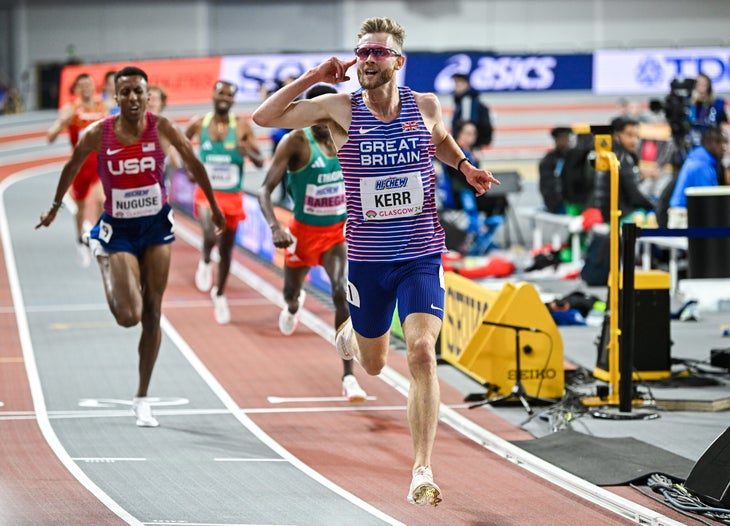
1. World Titles Are Best Won Through Rose-Colored Lenses
Want to be a world champion? See the world through rose-colored lenses. Or birth a baby. Or both.
Hear me out. St. Pierre and Scotland’s Josh Kerr both captured world titles in the 3,000 meters on Saturday. (Emphasis on indoor—the sun was nowhere to be found, if it ever is in Scotland.)
Their cutting-edge advantage: rose-tinted sunglasses.
Sure, maybe their fashion (err, equipment?) choice was a coincidence. But both had external lights to block out. Kerr from his rivals, and St. Pierre from those out of the know who doubted that she could return to the top of the sport after giving birth last March.
The quirky middle child who only gets to play during winter, the 3,000 serves a scapegoat for middle distance and distance runners alike who don’t want to show their cards in their marquee events too soon in the year, especially an Olympic year. That’s exactly what we saw on Saturday, when 1,500-meter specialists St. Pierre and Kerr elected to step up in distance to this event.
This race represented the ultimate homecoming for Kerr, 26, who grew up just an hour away in Edinburgh and trains with the Brooks Beasts in Seattle, Washington. It was also fueled with hype.
Last summer, a rivalry popped up between Kerr and reigning Olympic gold medalist Jakob Ingebrigsten after Kerr outkicked the 23-year-old Norwegian for the 1,500-meter world title in Budapest. The man to beat going into an Olympic year, Kerr practically drew a target on his back when he claimed he was going after Sir Mo Farah’s indoor two-mile world record of 8:03.40 at the Millrose Games in New York on February 11. Kerr backed up the claim, shattering the world record in 8:00.67.
After that race, Ingebrigsten, who is sitting out the indoor season as he nurses an Achilles injury, told TV2 in Norway that he could beat Kerr “blindfolded.”
Kerr officially had “no comment” to that quip a few days ago. He did his talking with his feet on the track.
On Saturday in Glasgow, Kerr overtook 10,000-meter world champ Selemon Barega of Ethiopia with 100 meters to go and steamrolled to the win in 7:42.98 in front of a roaring hometown crowd. When asked after his win if he thought Ingebrigsten tuned in to the race, Kerr replied, “I’m not sure he watches BBC 2.”
RELATED: Josh Kerr is Ready to Set the Track on Fire
Not to be forgotten, Yared Nuguse, the 24-year-old from Louisville, Kentucky, who put his dreams of becoming a dentist on hold to race as a professional runner for the On Athletic Club in Boulder, Colorado, threw down a monster kick over the final straightaway to sneak in front of Barega for silver and his first world medal.
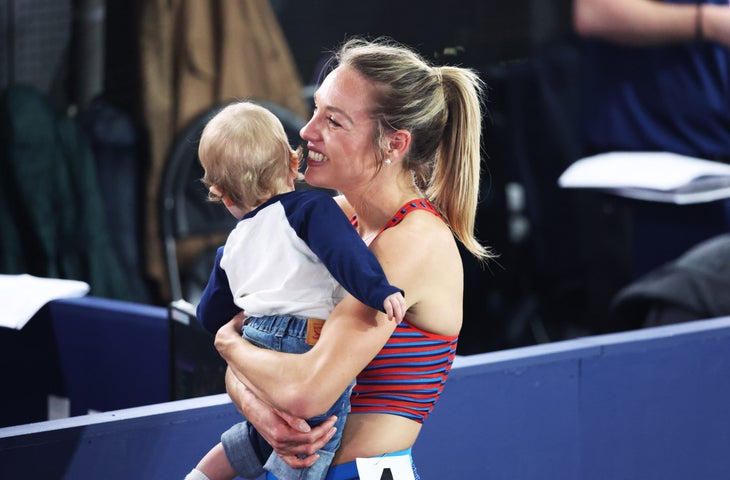
Meanwhile St. Pierre has mentioned she’s fielded seeds of doubt from people outside of the sport about whether she could bounce back after becoming a mom last March.
She laid those doubts firmly to rest on Saturday, shaving nearly five seconds off her PR to become not only the first mom, not only the first woman, but the first American ever to win a world title in this event.
“It’s a dream come true,” St. Pierre said. “It’s all kind of a blur. I was just waiting for it to get really, really bad and it never quite did. I just hung onto the pace, and I was like, ‘OK, OK, I think I can do a few more laps of this as long as it doesn’t pick up too much.’ And the next thing I knew there was 400 to go, and I knew I could run a fast 400 so I just hung on and believed in myself.”
Takeaway: Sunglasses or not, we could all stand to view the world through rose-colored lenses a little more frequently. And while the 3,000 meters won’t be run in Paris this summer, it very well may serve as a taster of what’s to come in the 1,500 meters.
2. New Moms Are Redefining What’s Possible
Just hours before St. Pierre’s groundbreaking win, Rachel Smith—who gave birth to her daughter Nova just over 10 months ago—outkicked fellow mother Kierra D’Amato at the 47th Gate River Run, which served as the USA track and Field 15K (9.3 mile) Road National Championship in Jacksonville, Florida.
The 32-year-old kept her cool on a muggy morning, attacking the final hill with less than a mile to go to overtake Emily Durgan and lock in on race leader D’Amato, 13 seconds ahead and far in the distance. Smith closed in a 4:42 mile to hammer past D’Amato on the final straightaway and break the tape in 48:26 (5:12 minute per mile average), four seconds ahead of second-place D’Amato.
“It’s a huge victory for me,” Smith, an Olympian in the 5,000-meters at Tokyo, said after the race. “I’m really savoring this one. “Turning onto that hill, I just kept repeating my family’s names in my head over and over. That brought me home.”
Smith says she was running not only for her daughter but also for her mom and for her dad, who was recently diagnosed with cancer.
View this post on Instagram
Meanwhile in Japan on Sunday morning, Betsy Saina, 35, who gave birth to her son Kalya in December of 2021, rebounded from a disappointing DNF at the U.S. Olympic Marathon Trials to take fifth at the Tokyo Marathon in 2:19:17—chopping a whopping 2:23 off of her PR. Averaging 5:18 pace, it’s the third fastest time ever run by an American, only behind American record holder Emily Sisson and D’Amato.
Takeaway: What’s up with the sudden new mom domination? It’s probably a confluence of variables, but we can’t discount the instrumental effect that advocacy by the likes of track and field stars Allyson Felix, Alysia Montaño, and Kara Goucher have had on athlete contracts. In 2019, all three broke their non-disclosure agreements with Nike, sharing how getting pregnant led to drastic salary reductions, low-ball renegotiations, and financial pressure to return to the top of the sport as fast as humanly possible—or faster. That outcry, and the public backlash that followed, led to a congressional inquiry and a new 18-month maternity leave policy for Nike, with many brands and the likes of the Professional Trail Association following suit.
With not only less postpartum pressure, but also the freedom to get pregnant during the prime of their careers, athletes are just beginning to show us what’s possible when empowered to do what’s best for them and their families. Don’t mess with a mom on a mission.
RELATED: 10 Key Takeaways from the Black Canyon 100K
3. Can Sprinter Noah Lyles Turn Running into Gold?
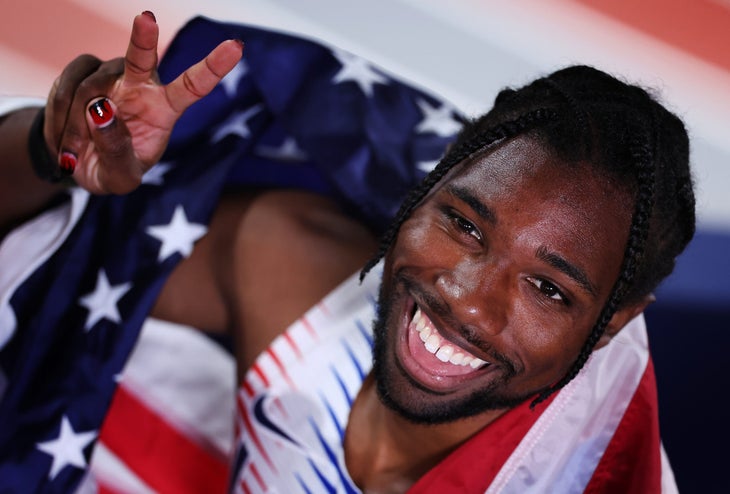
In the days leading up to the world champs, it was announced that Noah Lyles, 26, who won three gold medals at the World Athletics Championships in Budapest last summer, signed a new contract with Adidas that is reportedly the largest figure inked in track and field since Usain Bolt’s deal with Puma. It will run through the 2028 Olympics in Los Angeles.
Unfortunately, we don’t actually know what that number is, which is a huge bummer not only for fans, but for other athletes advocating for themselves in the sport. Lyles agrees.
“I definitely wish I could say what it was,” Lyles said. “I definitely asked [Adidas] multiple times.” He continued that non-disclosure agreements are “just something that’s been sucking since track and field started.”
But we do know that Bolt was making $10 million a year from Puma. That pales in comparison to, say, LeBron James, who’s base salary as a basketball star for the LA Lakers was $47.5 million last year. But let’s face it, track and field is hardly the NBA when it comes to domestic appeal.
That being said, Lyles’s new contract, on and off the track swag, and all-around emphasis on marketability puts a flag in the sand for what could come to the sport. Hell, he even re-engineered himself as an athlete to expand his range from the 200 meters to the 100 meters (and now even the 60 meters indoors) to be a bigger deal in the public eye.
He’s in the house 😮💨@LylesNoah enters the stadium in style ahead of the 60m semi-finals 👀#WorldIndoorChamps pic.twitter.com/pjOhiPqju0
— World Athletics (@WorldAthletics) March 1, 2024
Just a few days after the ink dried on his contract, Lyles added two silver medals to his hardware collection in Glasgow. One in the 60-meter dash behind fellow countryman Christian Coleman (who served a six-month ban from the sport for missing drug tests), and, in a massive display of range, the other in the 4×400-meter relay. (He was added as a late addition to the relay, which he cryptically announced on X.)
“Indoor is always the best way to receive a crowd,” Lyles, ever thinking about the fans, said after the 60-meter prelim, while also keeping his emotions in check. “Indoors is just indoors. We’re not stopping anything to get ready for this race. What we’re already doing just got us here, let’s just keep it going.”
In other words: watch out world, Lyles is fully focused on winning four gold medals in Paris.
Add in: long jumper Tara Davis-Woodhall pre-meet dancing, smiles for the camera, and parading around in a cowboy hat—energy which she backed up with her first world title. Grant Holloway’s mind blowing dominance in the 60-meter hurdles: he has not lost a single race since high school in 2015, and in Glasgow no one was anywhere close. And thrower Ryan Crouser’s teddy-bear like affability, who added an indoor world title to his two outdoor world titles and two Olympic gold medals. They’re at the top of a long list of characters who are injecting the sport with some much needed drama and personality.
Takeaway: Love them or hate them, these track and field stars are trending on X. And as they say, all publicity is good publicity when it comes to anything, including growing this sport. As far as I can tell, the biggest hurdle (no pun intended) to track and field athletes skyrocketing to stardom is the fact that Nike has a stronghold on all world championships through 2040, meaning that every single athlete must don the swish when the stakes and visibility are highest.
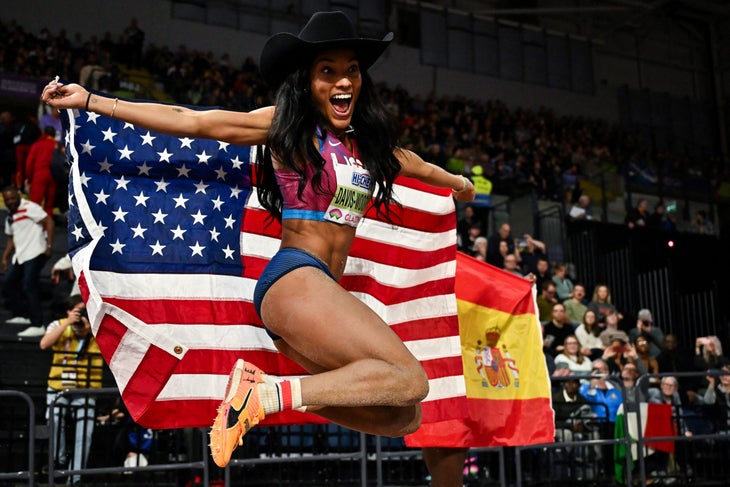
4. Is the Eliud Kipchoge Era Over?
Almost 6,000 miles away at the Tokyo Marathon on Sunday, Benson Kipruto of Kenya and Ethiopia’s Sutume Kebede ran the fastest marathons ever recorded on Japanese soil in 2:02:16 and 2:15:44, respectively. Eliud Kipchoge, one of the greatest runners to ever live and both the oldest pro and the pro with the fastest seed time, struggled. Kipchoge entered the race publicly stating that he was there not only to best his course record, but to stamp his ticket to the Paris Olympics and his shot at winning a third consecutive Olympic gold medal.
RELATED: What It’s Like To Run the Tokyo Marathon
Instead, Kipchoge detached from the front of the race before the halfway mark, fading into no man’s land before getting swallowed up by the chase pack which primarily consisted of elite Japanese runners. He pulled himself together over the final few miles to finish 10th in 2:06:50. But he got beat by four compatriots, including the third, fourth, and fifth-ranked Kenyans.
“That’s how it is,” Kipchoge said after the race. “Not every day is Christmas day.”
In other words, Kipchoge chalks his performance up to a bad day. Given he won the Berlin Marathon for a record-breaking fifth time in September, that self-assessment could very well be true. But even if Kipchoge still has it, can the man who struggled over the hills of the Boston Marathon handle the hills of Paris?
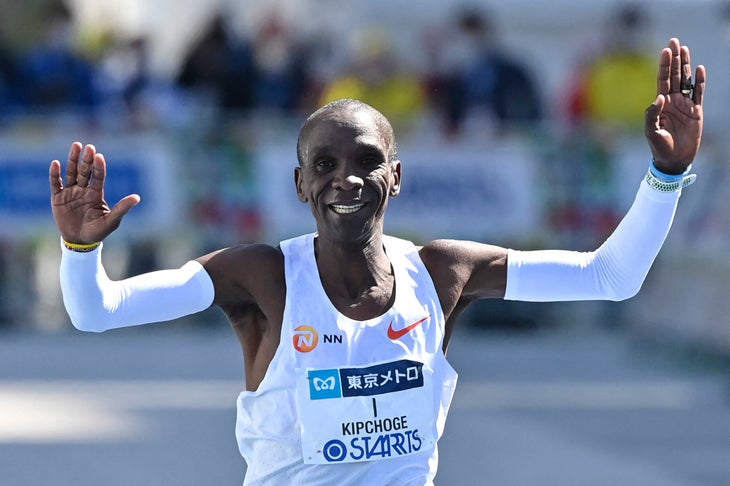
Takeaway: What will Kipchoge’s sub par showing mean for the Kenyan Olympic selection? (Unlike in the U.S. which holds an Olympic trials to determine Team USA, Kenya’s Olympic team is determined by committee.) Is Kipchoge past his prime? Will Kenya Athletics care?
The Tokyo Marathon was held just three weeks after the tragic death of Kenya’s Kelvin Kiptum, the world record holder in the marathon. His passing, along with Kipchoge’s disappointing performance, leave a hole at the top of the sport. Who will fill it?
In just 143 days, we’re about to find out.
RELATED: When Will Eliud Kipchoge Slow Down?
